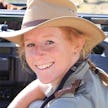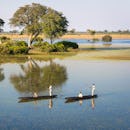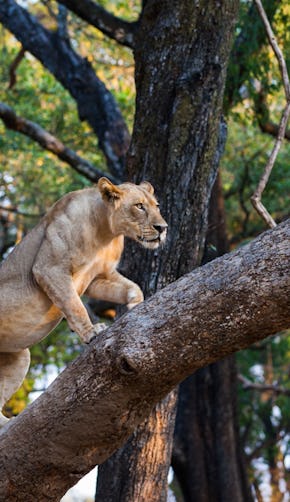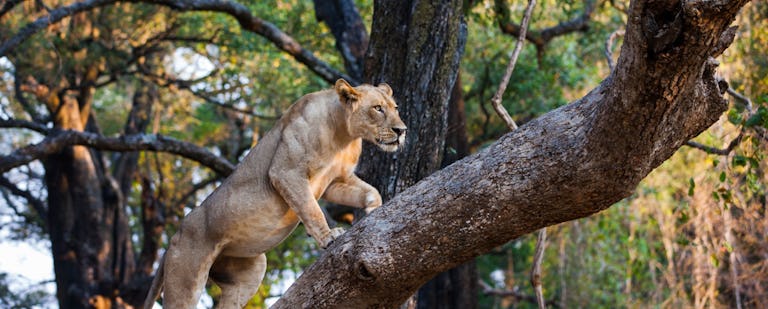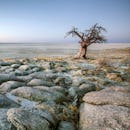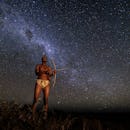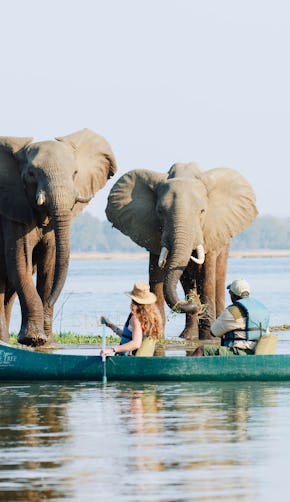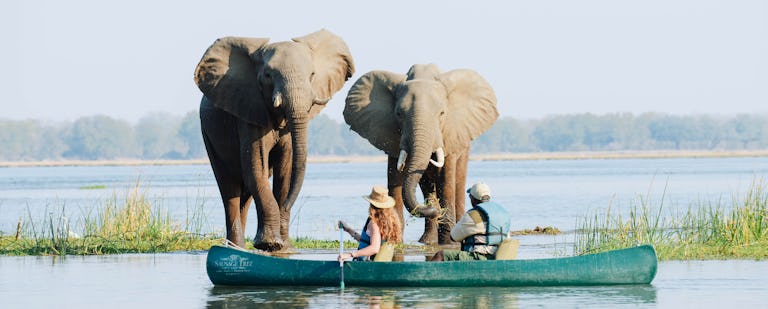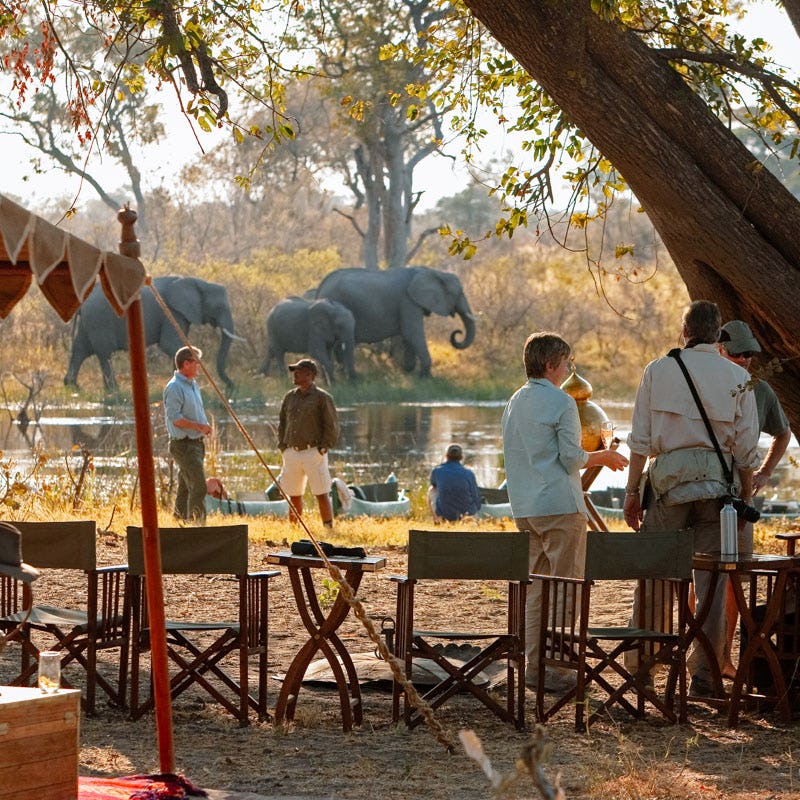Botswana is a country of legendary safari status, and the question we hear most often is, ‘When is the best time to visit Botswana?’ In all honesty (and as with many things in life) there’s no black and white answer. Each season has its own unique charms and experiences, and one person’s favourite time of year may well be someone else’s worst. To help kick-start your planning, we’ve come up with a broad guide to the seasons in each of Botswana’s safari hotspots. If you are looking for even more in depth Botswana tips, make sure to read our Botswana Travel Guide and, if you’re trying to save some pennies whilst travelling, check out How to plan an affordable Botswana safari.

Seasons
Generally, the climate in Botswana is typical for southern Africa. This means that June to October are considered the dry season months and bring with them little to no rain, bright blue skies and lots of sunshine. Conversely, December to March are the wet season months, or ‘green’ months as we prefer to call them, which leaves November and April/May, commonly known as the transition months, where just about anything can happen. So, what does all that mean for game viewing and when actually is the best time for a safari in Botswana?

December – March
First up is the green season and the months of December to March. Contrary to popular belief, it certainly doesn’t rain every day during this time and instead, you can expect dramatic thunderstorms mixed with sunshine and clouds – none of that infamous English drizzle here! For photographers, this is one of the best times to visit Botswana: the air is clear, the bush is luscious and green, and colours are kaleidoscopically beautiful. Game wise, it’s birthing season for antelopes across the country and the grassy plains are alive with springing babies, causing great excitement among the predators. Birding is also exceptional with the return of several of the most fascinating migrant species like carmine bee-eaters, European rollers and white storks.
Despite the abundance of rain in the green season, the water in the Okavango Delta actually begins to recede at this time of year, leaving behind a blanket of luscious grass. There are therefore more areas available for walking safaris and game drives on the exposed islands and plains, but mokoro safaris and other water-based activities (boat trips and fishing) may be slightly more limited. If floating along the waterways in a traditional mokoro is high on your bucket list, it’s certainly still possible – just make sure you choose a permanent water camp in the Delta. In the Kalahari, game viewing is quite simply spectacular, and here it could certainly be considered one of the best times to visit Botswana. The once sandy desert is covered in a carpet of lush green grass, attracting animals from far and wide, but what is most unique is the blossoming of desert bulbs and wild flowers in a riot of beautiful colour.
There are also fewer visitors during this time of the year, which you’ll really notice in places like Chobe, while in Linyanti, you’re more likely to spot rare species like pangolin during the green season.

April and May (and November!)
Often overlooked for a Botswana safari are the transitional times of the year (April and May, as well as November). At this time, the landscape is in a bit of a limbo period whilst it waits for the next season. Days can be bright or cloudy, sunny or rainy but the game viewing is generally very good and doesn’t differ much from the preceding months. Highlights in April include the arrival of the zebra of Africa’s second largest migration at the Boteti River (which can be viewed from the clifftop bedrooms at Meno a Kwena), whilst in November, they have made their way across to the Makgadikgadi Pans and are best viewed from Jack’s Camp or Camp Kalahari. In the Kalahari, it’s also a lovely time to meet the bushmen, away from the searing summer temperatures but not quite in the cold of the winter. If you’re willing to don a raincoat and embrace the element of unpredictability, then this is a lovely time for a trip and in fact one of the best times to visit Botswana on a budget with many camps offering deals that would be unheard of at other times of year.

June – October
Once again, the dry season months of June to October steal the spotlight for the ‘best’ time to visit Botswana – but we’ll leave it up to you to decide. In the Okavango Delta, it’s high-water season, and wildlife of all shapes and sizes migrate to the region in search of water, meaning superb game viewing all round. As water levels are high, it’s also the best time of year to enjoy an iconic mokoro or canoe safari, and float through the tranquil streams and rivers at leisure.
Further afield in the Linyanti, the Savuti Channel is one of the only permanent water sources in the area from June to October and it’s a magnet for thirsty animals, particularly big cats. Elephant viewing at this time is some of the best in Africa (try visiting the underground elephant hide at Hyena Pan in the Okavango Delta for a real treat!), and June, July and August are renowned for phenomenal wild dog sightings. Generally, the dry season is an excellent time to visit all areas in Botswana, but beware the rising temperatures towards the end of the season (September/October), particularly in the desert lands of the Central Kalahari.

Choosing your accommodation
Now that you’ve got all the info on the best time for a Botswana safari, it’s time to begin picking out just where to go – and where to stay. In Botswana, most lodges and camps remain open for the majority of the year, so the seasons don’t affect accessibility. However, in regions like the Okavango Delta, the location of a property and the water levels may influence the availability of certain activities like mokoro rides or boat trips. We always have a few recommendations up our sleeve when it comes to where to stay to really make the most of your Botswana safari, so read on.
Okavango Delta
Sable Alley, Khwai
Set in the heart of the awe-inducing Khwai Private Reserve, Sable Alley’s tented suites are strung along a permanent lagoon where a steady parade of wildlife arrives to quench their thirst. The camp also enjoys the combination of water and land-based safaris and, being one of only a handful of properties in the concession, you’ll feel like the sole visitor in this corner of the Okavango Delta.
Camp Xakanaxa, Moremi Game Reserve
A well-established and much-loved stalwart of the Okavango Delta, Camp Xakanaxa has fantastic year-round land and water-based activities. With a massive pool, firepit deck reaching over the lagoon and a well-curated library, the amenities are superb – and from one of the many vantage points, you can enjoy wildlife sightings to rival that of your game drives.
Gomoti Plains Camp, Central Okavango
With a wonderful location in the private Gomoti Concession, the light and lovely luxury tents all enjoy sweeping views of the river and wildlife-filled grasslands – this area is renowned for its predator spotting. You can also get an intimate experience of the Delta on fantastic bush walks, led by some of the best guides in the business.
Chobe Princesses, Chobe National Park
Take in the full scope of the Chobe River from one of these dreamy houseboats, each of which have four to five cabins, and can be booked exclusively. The staff are staggeringly good, as are the views, which you can enjoy from bed or the top deck for 360-degree panoramas. Keep your eyes peeled for huge pods of hippo and splashing elephant!
Moela Safari Lodge, Makgadikgadi Pans
With a perfect perch to enjoy all the wildlife action in the Boteti River Valley below, Moela Safari Lodge provides some of the finest ‘sofa safaris’ around – sit in the nest for soaring views or at eye-level with the animals. But that’s not all, there are also thrilling day and night drives, walking safaris with San bushmen and scenic helicopter flights to take in the surreal landscape.

Kings Pool Camp, Linyanti
Named after the hippo-filled oxbow lagoon at its forefront, Kings Pool Camp is pure luxury in the Linyanti concession. Wildlife viewing comes in a whole host of ways, from the sunken, hoof-level hide to sunset cruises on the camp’s very own barge. And the sheer number of animals in the area is unbelievable.
&Beyond Savute Under Canvas, Savuti
Moving every five days, this delightful camp takes a back-to-basics approach that puts the region’s spectacular wildlife viewing at the centre of your experience. You may just see lions on the hunt for elephant, thousands of migrating zebra and incredible packs of wild dogs. And the guides are phenomenal!
Dinaka Safari Lodge, Central Kalahari
Enjoying a prime spot in its own game reserve on the border of the Central Kalahari, Dinaka is an oasis of style and hospitality. From the cushy front deck, you can enjoy the comings and goings of its own waterhole, or head out on epic game drives to see more of the region’s unique wildlife. The sleepout is a must-do – the stargazing is spectacular and the sunrise, sublime.
Mashatu Main Camp, Tuli
Surrounded by the remote and rugged wilderness of northern Tuli, Mashatu Main Camp takes you on a journey of the mind and body. Enjoy its Discovery Room with relics from the area’s intriguing history, armchair safaris in front of the waterhole or get active on a mountain biking safari along well-worn elephant trails.
So, ultimately, when is the best time to go to Botswana? The answer is really determined by your expectations because each season brings its own magic and opportunities for an epic safari. If you need even more insider knowledge, our team of specialists are ready and willing to answer all your questions.





